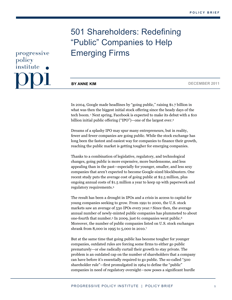 In 2004, Google made headlines by “going public,” raising $1.7 billion in what was then the biggest initial stock offering since the heady days of the tech boom. Next spring, Facebook is expected to make its debut with a $10 billion initial public offering (“IPO”)—one of the largest ever.
In 2004, Google made headlines by “going public,” raising $1.7 billion in what was then the biggest initial stock offering since the heady days of the tech boom. Next spring, Facebook is expected to make its debut with a $10 billion initial public offering (“IPO”)—one of the largest ever.
Dreams of a splashy IPO may spur many entrepreneurs, but in reality, fewer and fewer companies are going public. While the stock exchange has long been the fastest and easiest way for companies to finance their growth, reaching the public market is getting tougher for emerging companies.
Thanks to a combination of legislative, regulatory, and technological changes, going public is more expensive, more burdensome, and less appealing than in the past—especially for younger, smaller, and less sexy companies that aren’t expected to become Google-sized blockbusters. One recent study puts the average cost of going public at $2.5 million, plus ongoing annual costs of $1.5 million a year to keep up with paperwork and regulatory requirements.
The result has been a drought in IPOs and a crisis in access to capital for young companies seeking to grow. From 1991 to 2000, the U.S. stock markets saw an average of 530 IPOs every year.Since then, the average annual number of newly-minted public companies has plummeted to about one-fourth that number.In 2009, just 61 companies went public.Moreover, the number of public companies listed on U.S. stock exchanges shrank from 8,000 in 1995 to 5,000 in 2010.
But at the same time that going public has become tougher for younger companies, outdated rules are forcing some firms to either go public prematurely—or else radically curtail their growth to stay private. The problem is an outdated cap on the number of shareholders that a company can have before it’s essentially required to go public. The so-called “500 shareholder rule”—first promulgated in 1964 to define the “public” companies in need of regulatory oversight—now poses a significant hurdle to growth for many companies. These firms may not be ready or don’t want to go public but have few other options for raising capital because they can’t expand their investor pool. Thus, some companies nearing the 500-shareholder threshold may face an unpalatable choice: either bear the financial and regulatory costs of going public or forego opportunities for growth.
By raising the shareholder threshold to 1,000 or 2,000, as policymakers such as Sens. Tom Carper and Pat Toomey and Rep. David Schweikert have proposed, younger companies will have more room to grow, invest and create jobs, as well as more flexibility before making the plunge into going public. Coupled with other efforts to fix the broken IPO market, an amendment to this rule could give younger and smaller companies a much-needed boost toward growth.
Amending this rule would also be an important step in modernizing and reorienting the nation’s overall regulatory scheme toward promoting innovation—an effort that is crucial to America’s future economic renewal.